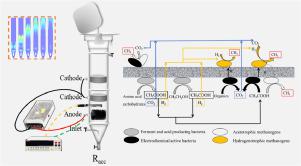Water Research ( IF 11.4 ) Pub Date : 2021-01-06 , DOI: 10.1016/j.watres.2021.116813 Lei Gao , Wenzong Liu , Minhua Cui , Yingshi Zhu , Ling Wang , Aijie Wang , Cong Huang

|
Compared with common anaerobic digestion, microbial electrolysis has been proven feasibly to accelerate biodegradation and methanogenesis with the advantages of effective electron flow regulation. However, its actual application and scale-up required a full understanding and further investigation on electrode size and distribution. For making full use of the space of the integrated reactor and improve methane recovery, an effective interior configuration was significant. In this work, three types of reactors with different cathode spatial distributions, that is, different cathode space ratios (ratio of cathode surface area to reaction region volume), were studied to form a good flow pattern for obtaining high methane production. Tracer experiments and numerical simulation were employed simultaneously for understanding the hydrodynamics characters of the interior flow field. The results showed that by increasing the cathode space ratio to 1.33 cm2/cm3 and 2 cm2/cm3, respectively, better flow patterns with the residence time of 1.336 times and 1.363 times of theoretical hydraulic retention time could be obtained. The stacked structure of nickel meshes was beneficial to prolong the contact time of contaminant and improve the mass transfer. Increasing the cathode space ratio could also enhance the electrochemical performance. Considering the organic removal, methane recovery, electrons generation, and material consumption, the recommended cathode space ratio was 1.33 cm2/cm3. With this structure, COD removal efficiency reached 93.2 ± 1.9% and 94.1 ± 1.5%, methane production rate reached 332.0 and 334.8 mL CH4/L reactor/day, and methane yield was 171.3 and 246.4 mL CH4/g COD under the HRT of 24 h and 36 h, respectively.
中文翻译:

上流式微生物电解辅助反应器中甲烷产量的增加:生物电极不同空间分布下的流体力学特性和电子平衡
与常规厌氧消化相比,微生物电解已被证明具有有效电子流量调节的优势,可加速生物降解和甲烷生成。然而,其实际应用和放大需要对电极的尺寸和分布有充分的了解和进一步的研究。为了充分利用集成反应器的空间并提高甲烷的回收率,有效的内部配置非常重要。在这项工作中,研究了三种具有不同阴极空间分布的反应器,即不同的阴极空间比率(阴极表面积与反应区域体积之比),以形成获得高甲烷产量的良好流态。同时采用示踪剂实验和数值模拟来了解内部流场的流体动力学特征。结果表明,通过将阴极空间比增加到1.33 cm分别为2 / cm 3和2 cm 2 / cm 3,可以获得更好的流动模式,其停留时间为理论水力停留时间的1.336倍和1.363倍。镍网的堆叠结构有利于延长污染物的接触时间并改善传质。增加阴极空间比也可以增强电化学性能。考虑到有机物的去除,甲烷的回收,电子的产生和材料的消耗,推荐的阴极空间比为1.33cm 2 / cm 3。采用这种结构,COD去除效率分别达到93.2±1.9%和94.1±1.5%,甲烷产生率达到332.0和334.8 mL CH 4/ L反应器/天,在24 h和36 h的HRT下,甲烷产率分别为171.3和246.4 mL CH 4 / g COD。











































 京公网安备 11010802027423号
京公网安备 11010802027423号